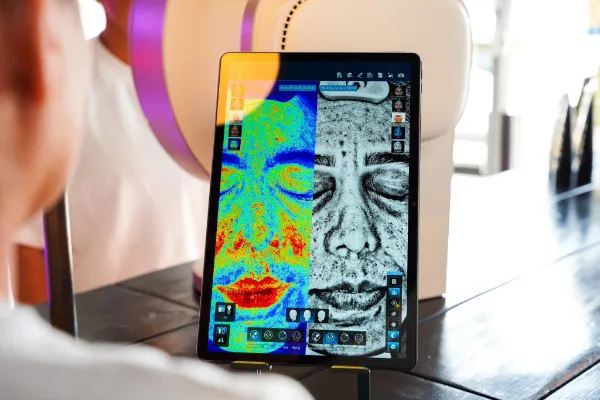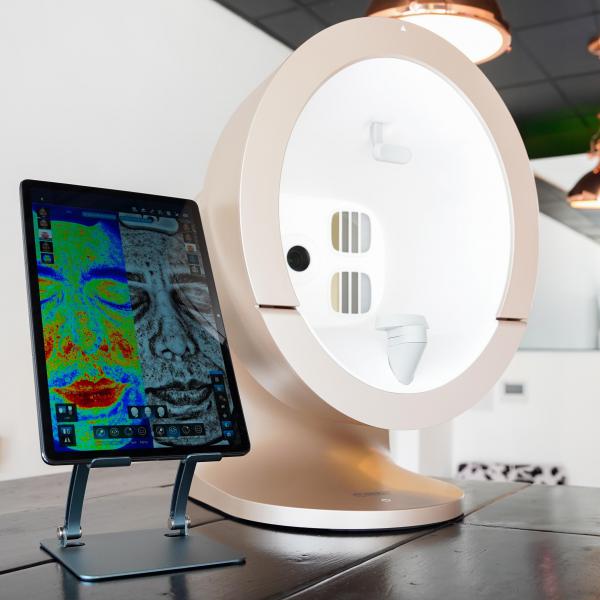
CPD Article: Under Analysis
The importance of skin analysis devices in skin and aesthetic clinics
From high-tech treatments to clinic software, technology has become an indispensable asset in enhancing client satisfaction, improving treatment outcomes, and building professional credibility within aesthetic clinics.
One of the most significant innovations in recent years is the skin analysis device. These devices, equipped with advanced imaging technology and artificial intelligence, provide a comprehensive, data-driven evaluation of the skin. When comparing clinics that use skin analysis devices to those that do not, the advantages are clear and far-reaching, impacting diagnosis, treatment planning, client education, and ultimately, business success.
1. Precision in diagnosis and treatment planning
Without a skin analysis device, practitioners must rely solely on visual inspection and manual assessment. While experience and expertise are valuable, human observation is inherently limited. Under natural or even magnified lighting, many underlying issues – such as sub-surface pigmentation, dehydration, inflammation, and bacteria – are invisible to the naked eye.
Skin analysis devices, by contrast, utilise multi-spectral imaging and UV, RGB, and polarised light to scan beneath the surface of the skin. This allows practitioners to detect concerns that are not yet visible, offering early intervention and more targeted treatment plans. For example, a practitioner might identify deep congestion, vascular damage, or melanin clusters that wouldn’t be otherwise noticed. This level of insight leads to far more accurate and individualised treatment recommendations.

2. Enhanced client education and trust
One of the key challenges skin clinics face is convincing clients of what their skin truly needs. Without visual proof, clients may be sceptical of suggested treatments or products. Clinics not using skin analysis devices often depend on subjective conversations, which may fail to communicate the full picture.
With a device, the results are displayed clearly and often in high-resolution images on-screen, giving clients a deep understanding of their skin’s condition. This visual evidence builds trust and increases client confidence in the practitioner’s recommendations. Clients are more likely to invest in treatments and homecare products when they can see the justification for them firsthand. The consultation becomes not just diagnostic, but educational, empowering the client and establishing a more collaborative relationship.
3. Objective progress tracking
In clinics that don’t use a skin analysis system, progress is typically evaluated through client feedback and before-and-after photos, which can be inconsistent and subjective. Factors like lighting, angles, and client perception can influence the accuracy of these assessments.
Skin analysis devices offer consistent, objective data over time. Practitioners can take follow-up scans and directly compare results to the client’s baseline, clearly showing improvements or regressions in hydration, pigmentation, pores, redness, and more. This reassures clients that their investment in treatments is paying off and keeps them engaged in long-term skincare journeys. It also helps adjust treatment plans dynamically to keep outcomes optimised.
4. Increased sales of skincare and treatments
By showcasing the condition of the skin and linking it to personalised recommendations, skin analysis devices are powerful tools for increasing retail and treatment sales. Clients are more motivated to follow through with full courses of facials, advanced technology treatments, or purchase professional-grade skincare when they understand the “why” behind each recommendation.
Clinics without a device must rely more heavily on verbal persuasion, which may be less compelling or perceived as sales-driven rather than science-backed. Data from leading clinics shows that those using analysis devices see higher average transaction values and increased client retention due to improved product uptake and service consistency.
5. Professional image and competitive edge
In an increasingly competitive market, standing out matters. Clients are becoming more knowledgeable and expect cutting-edge solutions. Clinics that incorporate skin analysis devices project a more modern, professional image. The presence of advanced technology suggests expertise, innovation, and a commitment to high standards of care.
Clinics that do not use such devices may appear less advanced or outdated, especially to younger or tech-savvy clients. As skin analysis becomes more common, particularly in premium and medical-grade clinics, those without it may be seen as falling behind.
6. Streamlined consultations and documentation
Skin consultations can be time-consuming and inconsistent if done manually. Devices help standardise the process, ensuring all relevant skin factors are captured in every appointment. They also often store client data securely, allowing for quick access to historical scans and notes, which is particularly beneficial for clinics with multiple practitioners or large client bases.
In contrast, without a device, documentation must be handwritten or manually entered, increasing the risk of errors or missed information. This can affect treatment quality and follow-up efficiency.
Conclusion
The use of a skin analysis device in a skin clinic is not just a luxury; it is becoming an essential standard of care. Clinics equipped with these tools provide more accurate diagnoses, stronger client trust, better treatment results, and higher commercial performance. They empower both practitioner and client through data, visibility, and education.
For More information visit https://lwaestheticdevices.com or call 07900 901486.
